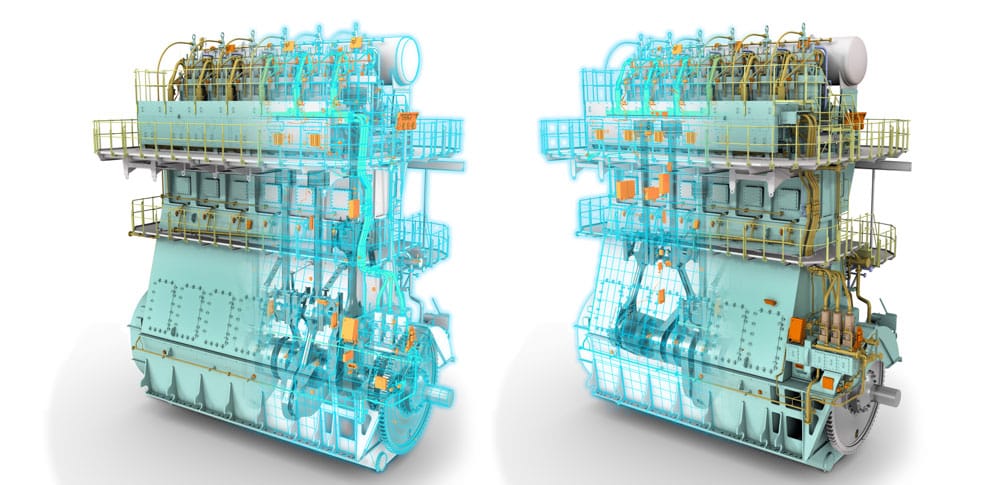A WinGD panel invited journalists in London to a preview of their roadmap towards 2050 emissions targets.
Reviewing the complex landscape of challenges to meeting the IMO deadline, Dr German Weisser, Senior Emissions & Sustainability Expert, outlined the difficulties in squeezing ever further and cleaner performance from basic technology that has already made massive movement over the last 60 years.
He stressed that both technological innovation and the global introduction of alternative fuels and/or energy sources for international shipping will be integral to achieve the overall ambition.

Drive to Reduce Emissions & Fuel Consumption
As marine engine designers, Wisser stressed, WinGD strive for higher efficiency, reduced emissions and lower costs. Comparing the possibilities of future marine fuels, from current fossil fuels including LPG and LNG to bio-fuels and hydrogen-based fuels, he detailed how, while any can be converted into propulsion power in low speed two-stroke engines with high efficiency, their viability as a fuel source were far from equal.
Potential reduction contributions would come from Smart Shipping and Engine efficiency advances but must be complemented by enhanced system integration, hybridization and optimisation. LNG as fuel, he said, is a significant step in the right direction, but on a long-term perspective it needs to be supported by
additional energy sources. Carbon-free/renewable fuels are also necessary for reducing CO2 emissions to levels required for IMO compliance.
Timing, he stressed, is a major factor. In reality solutions need to be available on the market by 2030 in order
to enable the necessary impact for 2050.
Consideration of potential Future Fuels had to include first whether combustibles were usable
without further (chemical) processing, and second their generation on the basis of the source of feedstock for physico-chemical treatment, or the degree of enhancement of natural processes.

Other onsiderations included aspects related to fuel production, production from different sources/feedstock.
Main Issues of using LNG instead of HFO include that tank volume needs to be 1.6 times higher, with insulation on top. Moving from LNG to Hydrogen (cryogenic) added a further increase of tank volume >2 times higher, and additional insulation on top.
Alternatives such as Ammonia and Methanol also carry a challenge on tank volume increase, weight increase
and toxicity. Batteries, compared to HFO, required storage volume min 8 times higher, and weigh more than 20 times as much.
To answer these questions, Weisser explained, WinGD has built a robust infrastructure to verify and compare future fuels. While the IMO GHG ambitions demand coordinated effort across the industry, and carbon-free/renewable fuels will be necessary. LNG, he concluded, may not be the ultimate answer, but it is the right step today.
Following the discussion of the roadmap, Thomas Werner, Engine Program Portfolio Manager reviewed WinGD’s current X-DF technology and its readiness to provide 2050 ready solutions.
Win GD’s X82DF/X82-D engines, the successful 82 bore engine series, have 250 units ordered. Following a first delivery in 2008, 223 engines are now in service. The X82-D will offer reduced BSFC, reduced engine length, easier maintenance of ICUs, WiDE for engine performance analysis and predictive maintenance, well proven piston running experience, extended time between overhauls. The X82-DF will round-out the WinGD dual fuel portfolio, and the DF concept with low-pressure gas admission is the market leader for LNG fuelled vessels.
Werner said the X-DF is the engine for 2050 and the X82-D and X82DF engines are the most competitive engines for VLCCs, VLOCs and Panamax Container Vessels.

